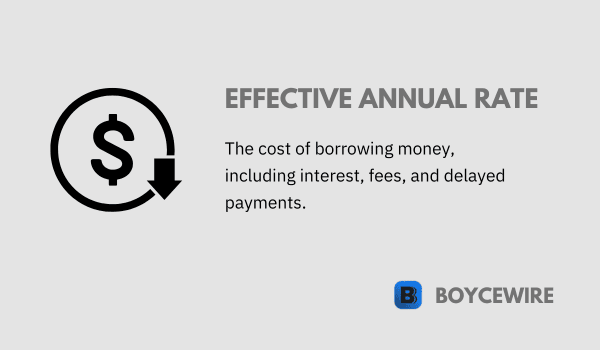Effective Annual Rate: Definition, How to Calculate & Examples

What is Effective Annual Rate?
The Effective Annual Rate (EAR), also known as the annual equivalent rate (AER), is a critical financial concept used to compare the annual interest between financial products that have different compounding periods. This rate is particularly essential in understanding the true return on an investment or the total cost of a loan.
While the stated annual interest rate does not account for compounding within the year, the EAR does consider compounding, making it an excellent measure to compare the economic effect of different loans or investments accurately. This way, it becomes easy for investors and borrowers to make informed decisions.
Key Points
- EAR represents the true annual interest rate, accounting for compounding, and is used to compare different financial products fairly.
- EAR considers the impact of compounding, which is the process of adding interest to the principal amount over time, resulting in more accurate calculations.
- EAR is calculated using the formula: EAR = (1 + i/n)^n – 1, where “i” is the nominal interest rate and “n” is the number of compounding periods per year.
Understanding the Effective Annual Rate (EAR)
The Effective Annual Rate (EAR) is a tool used to compare the annual interest rates between financial products, considering compounding. Compounding is the process whereby interest is added to the principal so that the interest that has been added also earns interest. This compounding can happen on any frequency schedule, from daily to annually.
A financial product with more compounding periods may have a higher effective annual rate, even if the stated interest rate is lower. This is because interest is being charged more frequently, allowing it to accrue faster. For example, if you have a credit card with a 12% stated annual interest rate that compounds monthly, the effective annual rate will be more than 12%.
The EAR is useful in comparing financial products because it allows for an apples-to-apples comparison. By looking at the EAR, consumers can easily see which financial product has a higher or lower rate, regardless of compounding frequency.
To summarize, the EAR provides a clearer picture of the actual interest rate you will pay or earn on a loan or investment, respectively, when compounding is taken into account. This understanding is crucial for making sound financial decisions.
Calculating the Effective Annual Rate (EAR)
The Effective Annual Rate (EAR) can be calculated using the following formula:
EAR = (1 + i/n)^(nt) – 1
Where:
- i is the nominal interest rate (also referred to as the annual percentage rate)
- n is the number of compounding periods per year
- t is the time the money is invested or borrowed for, in years
To illustrate how the formula works, let’s consider an example. If a loan or investment has a nominal interest rate of 5% compounded quarterly (i.e., four times a year), then the EAR would be calculated as follows:
EAR = (1 + 0.05/4)^(4*1) – 1
= (1.0125)^4 – 1
= 1.05095 – 1
= 0.05095 or 5.095%
So, while the nominal interest rate is 5%, the EAR, taking into account the quarterly compounding, is approximately 5.095%.
Understanding how to calculate the EAR is essential for consumers who want to accurately compare different financial products with different compounding periods. It allows them to identify which financial product offers the best terms.
Applications of the Effective Annual Rate (EAR)
- Comparing Investment Returns or Loan Costs The EAR is used primarily in comparing the annual interest between financial products that have different compounding terms. This is especially relevant in the case of comparing loans or investments where the compounding periods vary. Since the EAR takes into account the effects of compounding, it provides a more accurate measure of the actual cost or yield of a financial product than the nominal rate.
- Financial Planning Investors or borrowers use the EAR to plan their financial activities. For instance, knowing the EAR on their investments allows individuals to forecast their future wealth accurately. Similarly, knowing the EAR on a loan helps borrowers to understand the total cost of borrowing, aiding in effective debt management.
- Banking and Financial Institutions Banks and other financial institutions use the EAR to calculate the yield on various investment products and to set the interest rates on loans.
- Economic Analysis The EAR also serves as a useful tool for economists in comparing the growth rates of economies that have different compounding periods. For instance, if country A reports GDP growth on a quarterly basis and country B on an annual basis, the EAR allows for a meaningful comparison of their economic growth rates.
- Corporate Finance In corporate finance, the EAR is used in capital budgeting and valuation models to reflect the time value of money more accurately. In these scenarios, the EAR can provide more accurate results than the nominal interest rate.
Advantages of the Effective Annual Rate (EAR)
- Accurate Comparisons The primary advantage of the EAR is its ability to facilitate accurate comparisons between different financial products. Since the EAR takes into account the effects of compounding, it provides a more precise measure of the actual cost or return of a financial product than the nominal rate.
- Clarity in Financial Decisions Understanding the EAR can help individuals and businesses make informed decisions about where to invest or borrow money. For instance, a loan with a lower nominal rate but higher frequency of compounding can end up being more expensive than a loan with a higher nominal rate but lower frequency of compounding. The EAR can help to illuminate these kinds of distinctions.
- Better Financial Planning The EAR can also be a useful tool in financial planning. For instance, by knowing the EAR on their investments, individuals can more accurately forecast their future wealth. Similarly, knowing the EAR on a loan helps borrowers understand the total cost of borrowing, aiding in effective debt management.
- Industry Standard The use of the EAR has become standard in the financial industry. This uniformity of approach allows consumers to easily compare financial products across different institutions.
- Compliance with Legal Requirements In many jurisdictions, lenders are required by law to disclose the EAR to potential borrowers. This helps to ensure transparency and protect consumers from potentially deceptive lending practices.
Limitations of the Effective Annual Rate (EAR)
- Does Not Consider Variable Rates One significant limitation of the EAR is that it assumes a constant interest rate. In reality, interest rates can vary over time, especially for long-term loans or investments. This can lead to discrepancies between the calculated EAR and the actual cost or return of a financial product.
- Complications with Fees and Penalties The EAR may not fully reflect the total cost of a loan if there are additional fees or penalties associated with it. For instance, some loans may come with origination fees, service charges, or penalties for late payment, none of which are factored into the EAR.
- Assumes Compound Interest The EAR calculation is based on the principle of compound interest. While this is a standard practice in many financial products, some types of loans or investments may use simple interest, making the EAR an inaccurate measure of cost or return.
- Does Not Reflect Risks The EAR provides an indication of the cost or return of a financial product but does not reflect the risk associated with it. For example, an investment may have a high EAR but also carry significant risk.
- Misunderstandings and Misinterpretations Despite its advantages, the concept of EAR can be complex and may lead to misunderstandings or misinterpretations, particularly among individuals with limited financial literacy. This can make it difficult for some consumers to use EAR effectively in their financial decision-making.
Examples of Effective Annual Rate (EAR)
- Credit Card Loans Consider a credit card that charges 1.5% interest per month. While it might seem like the annual interest rate is 18% (1.5% x 12 months), due to the compounding effect, the EAR is actually higher. Using the formula for EAR: (1 + 0.015)^12 – 1, we find that the EAR is approximately 19.56%.
- Savings Accounts Suppose you have a savings account that pays 5% annual interest, compounded monthly. The monthly interest rate is 5%/12 = 0.4167%. Using the EAR formula, we find that the EAR is approximately 5.12%, which means you’ll earn slightly more than 5% due to the effects of compounding.
- Auto Loans Consider a car loan with an annual interest rate of 9% compounded quarterly. The quarterly interest rate is 9%/4 = 2.25%. The EAR for this loan, calculated as (1 + 0.0225)^4 – 1, is approximately 9.31%. This figure represents the real yearly interest rate paid on the loan, considering the effects of compounding.
FAQs
The Effective Annual Rate (EAR) is a financial metric that represents the true annual interest rate, accounting for compounding effects on loans and investments.
The nominal interest rate is the stated annual interest rate, while the EAR takes into account the frequency of compounding, providing a more accurate measure of the actual interest rate.
The EAR allows borrowers and investors to compare different loan and investment options accurately, helping them make informed financial decisions.
The EAR can be calculated using the formula: EAR = (1 + i/n)^n – 1, where “i” is the nominal interest rate and “n” is the number of compounding periods per year.
About Paul
Paul Boyce is an economics editor with over 10 years experience in the industry. Currently working as a consultant within the financial services sector, Paul is the CEO and chief editor of BoyceWire. He has written publications for FEE, the Mises Institute, and many others.

Further Reading
 Expansionary Fiscal Policy: Definition, Examples & Effects - Expansionary fiscal policy refers to a policy that seeks to grow the economy through fiscal stimulus.
Expansionary Fiscal Policy: Definition, Examples & Effects - Expansionary fiscal policy refers to a policy that seeks to grow the economy through fiscal stimulus.  Adjusted Gross Income - Adjusted gross income refers to an individual's total income from all sources, minus specific deductions and exemptions, and serves as…
Adjusted Gross Income - Adjusted gross income refers to an individual's total income from all sources, minus specific deductions and exemptions, and serves as…  Market Failure: Definition, Causes & Examples - A market failure is said to occur when there is an inefficient allocation of resources. This can occur when the…
Market Failure: Definition, Causes & Examples - A market failure is said to occur when there is an inefficient allocation of resources. This can occur when the… 